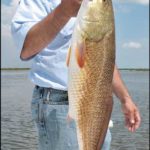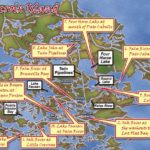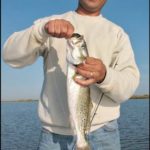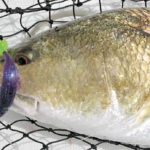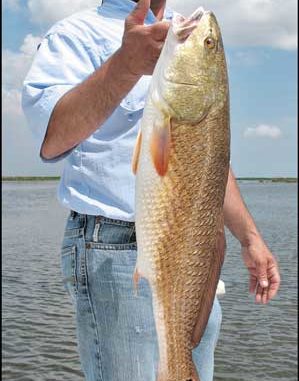
There are almost too many options this month for anglers out of this popular port.
The problem anglers face in May is not whether to go fishing, but where. The action turns on all over the state this month, and virtually any area you pick will be a winner.Even when you narrow your choice down to a particular area, you still face the same dilemma. Say, for instance, you decide to fish Delacroix Island this month, which is an excellent choice. Where do you fish in Delacroix?
Our options really do abound! Do you head up and fish toward Lake Robin, Lake Coquille or Calebasse? Or do you fish Four Horse, Lake Campo and Oak River Bay? Do you forget about the inside altogether, head straight for Black Bay and fish structure and islands?
Decisions, decisions, decisions.
Once May comes around, I get the urge to point my bow to the outside. I feel like the long, cold winter and windy spring has kept me cooped up for months, and now some primal instinct draws me to the big waters of the outer bays. I want to crank up the big outboard and run it all the way to Black Bay. I want to fish all the areas I love to fish in late spring and early summer — like Stone Island and the reef that once was Lonesome Island. I want to fish Iron Banks and the myriads of broken islands and near-shore structures.
I’m like a kid after a long, rainy day, and now that the sun is shining, I just want to go outside and run.
But somewhere in the back of my mind a little voice is speaking. It’s reminding me of the price of fuel. I quickly calculate that at $3.50 per gallon, and my 250 Yamaha averaging 3 miles per gallon, it costs me roughly $1.16 per mile to travel by boat — just for fuel.
If you fish out of a 24-foot bay boat, your fuel costs will be about the same. So if you are fishing in Lake Robin, and decide to make the run to Mozambique Point, that’s about 6 miles or $7. Each way.
Suppose you decide to run from Mozambique to Stone Island. That’s 4 miles, or almost $5, each way. From the end of the short rocks to Deadman Island, 2 1/2 miles, or about $3, each way. Or let’s say you are fishing around Lake Anastasia, and you decide to make the run to the end of the MRGO rocks. Figure 9 miles, or almost $10.50, each way.
Is this the way exorbitant fuel prices will force us to fish from now on? Having to calculate what each run will cost, and then trying to decide if the potential justifies the expense? Will our itch to run all the way to the big outside waters be curtailed by the big price it’ll take to scratch it?
I called on Capt. John Serigne (504-451-5992), son of Lionel and Joan of Delacroix’s Serigne’s Marina, a long-time landmark of the fishing community. John Serigne grew up in the Delacroix Marsh, and has fished, shrimped, hunted and crabbed his entire life. He started guiding after Hurricane Katrina, and I recently asked him if it is possible to have a great day fishing in the Delacroix area, in May, without having to run all the way outside.
“Absolutely,” he replied confidently. “You’ll have to run some, but not all the way outside, and you’ll catch plenty fish.”
And to prove it, he invited me fishing.
I climbed aboard Serigne’s 24-foot Triton at the dock alongside the family marina. Daylight was just breaking, and the 225 Yamaha was already purring. I stowed my gear, and Serigne pointed the bow toward Bayou Gentilly and then to Little Lake. We crossed Little Lake and took the Pencil Canal all the way to Oak River, where we took a left and stopped the boat in the middle of Oak River.
“We’re going to troll with the trolling motor and fish all up in this section of Oak River,” he said. “The trawling season doesn’t usually open until the end of the month on this side of the river, so the trout will still be inside. You’ll catch fish outside, too, of course, but you won’t have to run that far yet to get into some good action.
“The fish have been in Oak River all winter and through the spring. Sometimes the bite is off, and sometimes they may be scattered, but the fish are always there. And they’re in here now,” he said as he set the hook on a decent trout that jumped up immediately to the surface and shook violently in protest all the way to the boat.
Serigne was fishing with a smoke-colored Hybrid on a 3/8-ounce jig head. My plastic was mounted on a ¼-ounce jig, and he recommended I immediately change to a heavier weight. I made one more cast and couldn’t feel bottom, so I reeled in and took his advice, switching to a blue moon Deadly Dudley on a 3/8-ounce jig.
Serigne’s technique is to cast into the middle of Oak River, let the bait sink to the bottom, and then slowly work it back to the boat. He used a steady retrieve, not fast, but not really slow like you’d use in the winter months. I kind of hopped my bait back toward me, careful to keep the slack out of my line so I could feel the fish when they bit. And the fish were in there.
But it was strange the way these fish hit. Occasionally I’d get a good thump on the end of my line, the way you’d expect fish to bite at this time of year. But most often, I felt only some resistance when I reeled in, almost like I had picked up grass. It seemed like the trout were sucking in the bait and swimming with it, and only when they turned off did we both realize they were hooked.
Serigne used the trolling motor, and also let the boat drift back and forth to each side of Oak River, but mostly we fished in the middle. The bite was slow but steady, and patience was the key word of the day.
This isn’t the fast-and-furious action soon to come in Black Bay and Breton Sound, but we were steadily putting fish in the box, and at the rate we were adding them, I knew we’d have our limits — or very close to them — by the end of the trip.
I tried fishing under a cork closer to the bank once the sun got high in the sky, and managed a couple hits, but by far the best action came from tight-lining plastics.
Serigne manned the trolling platform on the bow in bass-fishing fashion. He had three spinning reel combos up front on the deck. All three were mounted with different-colored Hybrid lures on 3/8-ounce jigs. He’d fish with one color for a while, and then switch rods and fish with another.
“I stick with the same kind of lure almost all the time,” he said. “I use a Cocahoe-type lure — Hybrids, Dudleys, H&H — in several different colors, and that’s all I toss until shrimp season. Occasionally I’ll snap on a popping cork, and I’ll probably do that more as we get into May, but I mostly tight-line just like we’re doing today.”
We made a couple of moves over the course of the day to try some other spots and to chase some reds, and in almost every place we stopped, we had at least a few hits. Serigne says there are plenty of trout still inside, and they will stay there throughout the month of May.
Following are some other spots that will be productive this month:
1. Oak River at Little Crevasse.
“Try this whole area, both in the deeper water along the drop-offs, and over the shallow flats,” he said. “Fish tight-lined and under a popping cork in the shallow water.”
2. Oak River at the washouts to Lost Flat Bay.
“Troll and cast,” he said. “The fish like to hang on the ledges. Let your bait dribble down the drop-offs, and keep the slack out of your line. I’d fish the drop-offs tight-lined, and throw into Lost Flat under a cork.”
3. The hole in Bayou Ponton at Bay Ponton.
“It drops down pretty deep at that hole, and the trout do hang in there even in May,” he said.
4. Skippy Lake at Oak River.
“There is no name on it in the charts, but everybody knows it as Skippy Lake, from the Pencil Canal just before Oak River,” he said. “It’s a good place to drift and fish under a cork. If you find some fish, stick your Cajun anchor over, and try to stay with the action.”
5. False River at Branville Bay, and the mouths of the bayous in the back.
“Another good place to fish both tight-lined and under a popping cork,” Serigne said.
6. False River at Pato Caballo.
“We call this lake ‘Little Four Horse,’ but whatever you call it, don’t be in a hurry to pass it up,” he said. “The point where False River enters it is a good place to pick up reds and specks. I like to toss beetle-spins up close to the bank for the reds, but plastics, spoons or dead bait under a cork will work, too.”
7. Four Horse Lake at the mouth of the cut to Pato Caballo.
“Drift that whole area. It’s usually productive this time of year,” he said.
8. Lake John at the Twin Pipelines.
“Anchor in the Twin Pipelines, and fish the drop-offs,” he said.
9. Round Lake at the mouths of all the bayous.
“There’s two ways to fish the mouths: You can anchor in the mouth and fish, or you can drift and troll — whichever way you prefer,” he said.
10. Lake Fausan at the mouth of False River.
“Drift, troll and fish under a cork and tight-lined,” he said.
Other spots will be productive as well.
“If you want to run a little farther, head to the big bays — Oak River Bay or Bay Lafourche — and fish any of the points where you find some good current,” Serigne suggested. “Look for birds because they will be flying this month.”
So, there you have it. You can scratch the itch and run far outside this month to chase visions of grandeur at islands and structures in Black Bay. There will be some good fish out there.
Or if you listen closely, you might hear a little voice reminding you of the cost of fuel. It could be an expensive itch to scratch. You might want to consider these Delacroix options.
Decisions, decisions, decisions.
But with these options, you can hardly choose wrong.
Capt. John Serigne can be reached at (504) 451-5992.
